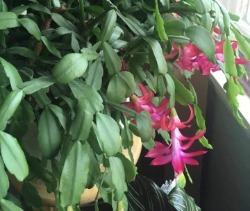Getting Holiday Cacti to Rebloom
The holiday cacti are coming!!! It’s almost time for the Thanksgiving and Christmas cactus to start appearing in stores all over the area. Holiday cacti are relatively easy to help rebloom every year and will often bloom twice a year if conditions are right. It’s time to provide your holiday cacti with a couple of conditions to get beautiful blooms this winter.
Holiday cacti are short-day plants and require long nights to bloom. Like a poinsettia, provide them with 13 hours of darkness over 6-8 weeks to get blooms to initiate. If you want your holiday cacti to bloom for Thanksgiving or Christmas, we are in the window to start providing those hours of darkness to encourage blooms. Unlike poinsettias, holiday cacti have another way to get them to bloom. If holiday cacti have 6-8 weeks of night temperatures of chilly night air (50-60 degrees F), that will also encourage our cacti to initiate bloom buds. A cool garage, outside on a covered porch (be sure the temperatures don’t get too cold), or a basement can provide the needed temperatures to encourage bloom buds.
Once you have bloom buds initiated, be careful not to “shock” your plants with cool drafts; getting too dry or having too little humidity can cause the plant to drop its buds. The buds will last longer if kept in cooler temperatures; however, they will still provide a beautiful display under most home temperatures.
These beautiful tropical cacti can be kept for decades. I have one in my home that is well over 100 years old right now, and it provides a beautiful bloom display year after year. Once they are done blooming, treat them like a houseplant with bright indirect light and water when the top few inches of the soil dry out. Once our temperatures warm up in the spring, move the plants outside in an area that gets partial sun (3-6 hours of sunlight) and fertilize regularly.

Have questions? Contact our office where our Horticulture Extension Agent will assist you with questions.
Phone: (316) 321-9660
Email: callae@ksu.edu
